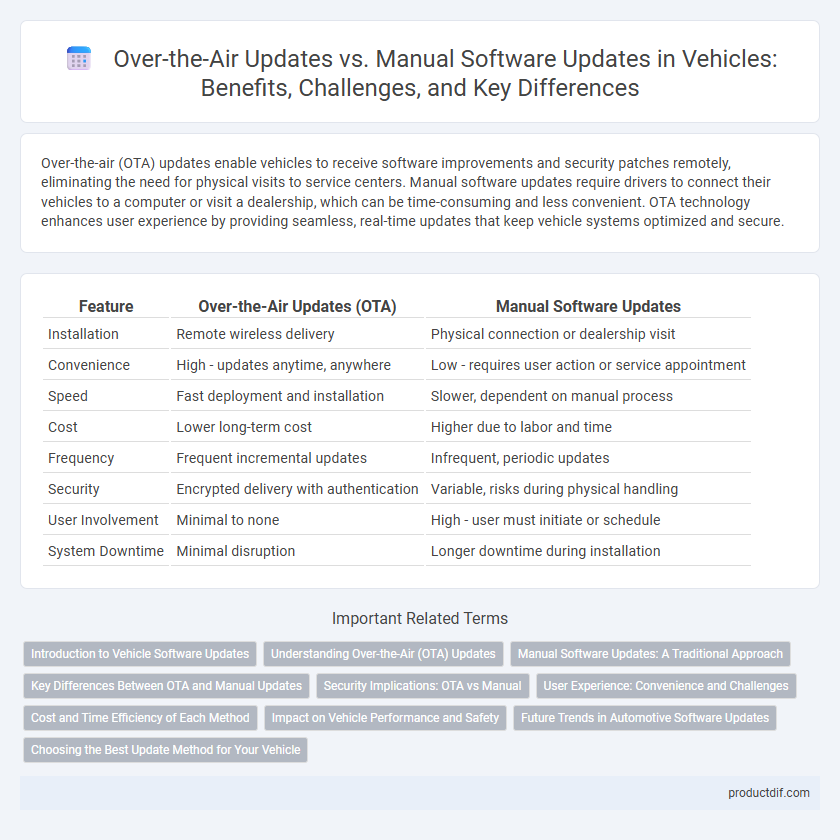Over-the-air (OTA) updates enable vehicles to receive software improvements and security patches remotely, eliminating the need for physical visits to service centers. Manual software updates require drivers to connect their vehicles to a computer or visit a dealership, which can be time-consuming and less convenient. OTA technology enhances user experience by providing seamless, real-time updates that keep vehicle systems optimized and secure.
Table of Comparison
| Feature | Over-the-Air Updates (OTA) | Manual Software Updates |
|---|---|---|
| Installation | Remote wireless delivery | Physical connection or dealership visit |
| Convenience | High - updates anytime, anywhere | Low - requires user action or service appointment |
| Speed | Fast deployment and installation | Slower, dependent on manual process |
| Cost | Lower long-term cost | Higher due to labor and time |
| Frequency | Frequent incremental updates | Infrequent, periodic updates |
| Security | Encrypted delivery with authentication | Variable, risks during physical handling |
| User Involvement | Minimal to none | High - user must initiate or schedule |
| System Downtime | Minimal disruption | Longer downtime during installation |
Introduction to Vehicle Software Updates
Vehicle software updates enhance performance, security, and functionality by addressing bugs and introducing new features. Over-the-air (OTA) updates deliver these improvements wirelessly, enabling seamless installation without visiting a service center. Manual software updates require physical access to the vehicle, typically involving a technician or user intervention via USB or diagnostic tools.
Understanding Over-the-Air (OTA) Updates
Over-the-Air (OTA) updates enable vehicles to receive software improvements remotely through wireless networks, eliminating the need for dealership visits. This technology allows manufacturers to deploy crucial enhancements, security patches, and feature upgrades directly to the vehicle's control systems in real-time. OTA updates improve user convenience, reduce maintenance costs, and ensure that vehicle software remains current without interrupting daily use.
Manual Software Updates: A Traditional Approach
Manual software updates in vehicles require physical connection to a diagnostic tool or USB device, making the process time-consuming and dependent on dealership visits. This traditional approach often leads to delayed implementation of critical security patches and feature enhancements, impacting overall vehicle performance and safety. Despite these limitations, manual updates remain essential for certain models lacking Over-the-Air (OTA) capability or in regions with limited internet connectivity.
Key Differences Between OTA and Manual Updates
Over-the-air (OTA) updates enable vehicles to receive software enhancements wirelessly, eliminating the need for physical intervention at service centers. Manual software updates require local dealership visits or owner-initiated downloads via USB or other media, often leading to longer downtimes and higher labor costs. OTA updates offer real-time deployment, improved security patches, and enhanced user convenience compared to traditional manual methods.
Security Implications: OTA vs Manual
Over-the-air (OTA) updates enhance vehicle security by enabling timely patches against emerging cybersecurity threats without requiring physical access, reducing vulnerability windows significantly. Manual software updates, relying on dealership visits or owner intervention, often result in delayed implementation, exposing vehicles to prolonged security risks. Robust encryption protocols and authentication mechanisms in OTA systems ensure data integrity and prevent unauthorized access during wireless transmission, surpassing the security measures typical of manual update processes.
User Experience: Convenience and Challenges
Over-the-air (OTA) updates enhance vehicle user experience by enabling seamless, wireless software improvements without dealership visits, significantly reducing downtime and increasing convenience. Manual software updates require physical connection at service centers, often causing delays and inconvenience due to scheduling and travel time. Challenges with OTA updates include potential cybersecurity risks and dependency on stable internet connectivity, while manual updates face limitations in scalability and user accessibility.
Cost and Time Efficiency of Each Method
Over-the-air (OTA) updates significantly reduce costs and time by eliminating the need for dealership visits and physical hardware, enabling instant deployment of software improvements directly to vehicles. Manual software updates require extensive labor and vehicle downtime at service centers, increasing operational expenses and delaying access to critical features or security patches. OTA technology streamlines maintenance workflows, lowers update distribution expenses, and enhances overall vehicle uptime compared to traditional manual methods.
Impact on Vehicle Performance and Safety
Over-the-air (OTA) updates enable vehicles to receive real-time software enhancements, improving performance metrics such as engine efficiency and autonomous driving capabilities without requiring dealership visits. Manual software updates often involve downtime and delay the deployment of critical safety patches, potentially exposing vehicles to cybersecurity vulnerabilities. The continuous, rapid deployment of OTA updates ensures timely resolution of performance issues and safety flaws, enhancing overall vehicle reliability and passenger protection.
Future Trends in Automotive Software Updates
Future trends in automotive software updates emphasize Over-the-Air (OTA) updates due to their ability to deliver real-time enhancements and security patches without requiring dealership visits. Increasing integration of OTA technology supports autonomous driving systems and connected vehicle ecosystems, ensuring continuous improvement and adaptability. Manual software updates are expected to become rare, reserved mainly for critical hardware interventions or unsupported legacy systems.
Choosing the Best Update Method for Your Vehicle
Over-the-air (OTA) updates offer convenience, allowing vehicles to receive software enhancements remotely without visiting a service center, ensuring timely improvements in performance and security. Manual software updates require physical connection to diagnostic tools at authorized dealerships, which can be time-consuming but allows for thorough inspection and immediate issue resolution. Choosing the best method depends on your vehicle model compatibility, update urgency, and preference for professional oversight versus automated convenience.
Over-the-Air Updates vs Manual Software Updates Infographic

 productdif.com
productdif.com